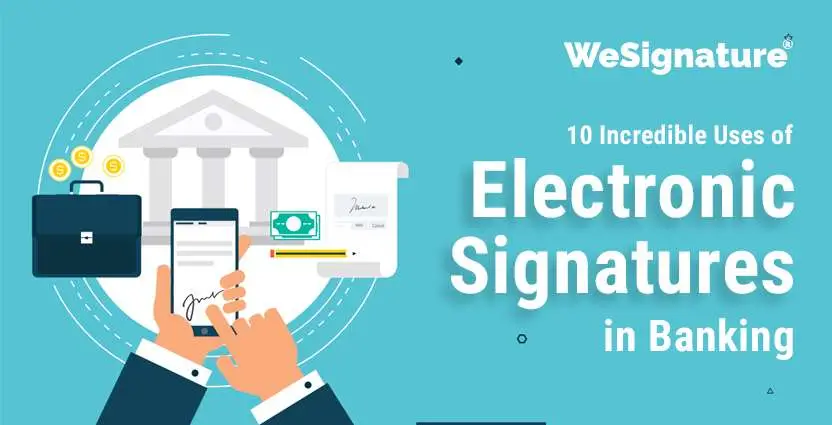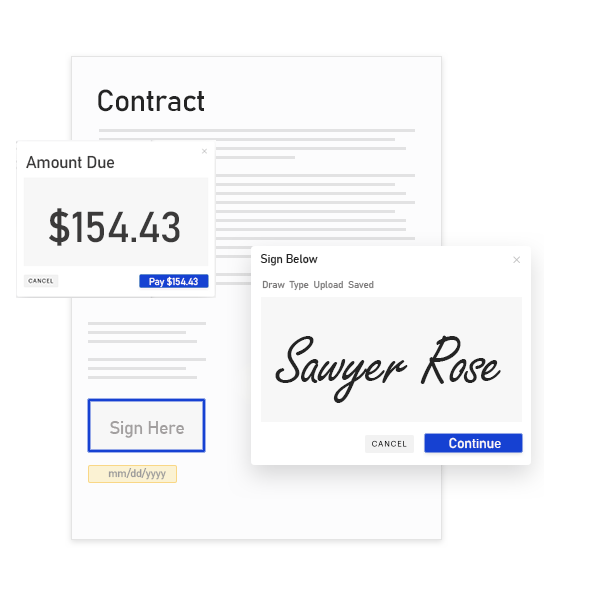10 Incredible Uses of Electronic Signatures in Banking

Do you want to know some outstanding uses of electronic signatures in banking? If yes, you have landed at right place.
The banks and other financial service providers are on their path to digitizing their business processes for offering a much better customer experience while simultaneously improving compliance.
Positively, the best electronic document signing software is created on the technology that offers a secure and compliant way to automate transactions that need a customer’s signature.
In the past, people went to banks for getting loan approvals, other investments, and account openings, but today creating electronic signatures in word help in signing documents anywhere and at any time.

Supplement Your Remote Working and Go Paperless With E-Signature Adoption
WeSignature is an electronic signature service for small businesses that enables quick, productive, cost-effective, and legally compliant document signing process. Adopt this solution today and transform your business completely.
This change does not only improve customer experience but also makes things simple. Furthermore, the implementation of electronic signatures in banking helps in bringing quantifiable results such as cost reduction, better customer experience, and quick transactions.
However, there are many ways in which an electronic signature benefits the banks. Given below are some of the most important Uses of Electronic Signatures in Banking mentioned in complete detail.
8 Astounding Uses of Electronic Signatures in Banking
1. Cost Savings
Any manual and paper-based processes during a typical customer onboarding process can cost a lot as compared to electronic document processing. Banks collectively get together to send hundreds of millions annually for correcting the documents across all lines of business.
By creating an online signature, the financial institutions can eliminate all errors such as missing signatures and data by using signatures that can easily incorporate workflow rules into automated processes. These signatures can also cut costs even more by getting rid of paper-dependent processes involving large volumes of manual processing methods, paper storage, and data re-keying.
Another example of a task that is expensive and time-consuming is the creation, management, storage, and retrieval of paper signature cards. Replacing these with secure e-signature software allows the banks to reduce paper consumption and administer overheads remarkably.
2. Productivity
With the use of e-signature online, the staff and advisors can spend much more building relationships with the customers and lesser time trudging through the administrative chores.
A large amount of time is spent while printing forms, storing information, scanning, photocopying, and imaging for getting documents back into the digital format. The e-signature implementation allows bankers to have higher-value conversations with customers.
3. Speed
The use of electronic signature online cuts the document workflow cycles from weeks to days and sometimes even minutes. On the other hand, with a web or mobile browser, workflows have the ability to get completed way more quickly without compromising on security and compliance.
This is exactly the case for a signature mortgage. At the present time, the loan origination system generates a mortgage application within only minutes of customers and representatives speaking on the phone.
From there on, an employee sends an email to the applicants inviting them to log in on a safe website where it is possible to review, accept, and sign documents. The job is now done within one or two days as opposed to seven or ten days which also means that the loans can be closed very quickly.
4. Customer Loyalty
Giving the customers freedom to select how and where they should transact with a financial institution can be considered priceless. The financial institutions should prepare for a customer who researches an account on the internet, starts an application, begins a chat session, and sends the supporting documents.
At other items, a customer can choose to do all this but still choose to visit a branch for sealing the deal. The key is to allow the customers to decide.
Using the electronic signature in banking offers a relatively easier, comfortable, accessible, and personal experience. These are all some qualities that create lasting connections.
5. Expanded Reach
With the online signature technology, there are many ways of collecting signatures including the click to sign and scripted signatures that are drawn on the mobile touch screens.
The mobile capabilities can change the game considerably when it comes to geographic boundaries. Using electronic signatures extends a financial institution’s reach without paying the cost of opening and staffing any new branches. This leads to better opportunities and success in the long run.
6. Efficiency and Transparency
The lending process from banks can be a long and drawn-out ordeal that can be equally frustrating for the customers and a banking institution. So many loan applications filled out by a customer require a signature from multiple people and their businesses.
When the agreements are sent on paper or via fax, it can become challenging to understand where the customers are in the signing process.
The use of electronic signatures in banking enables great transparency for institutions to see where the customers are in a signing process.
This gives the bankers the ability to take action for moving it along the process by sending reminder emails or sending it to a different signer completely.
Electronic signatures in banking save time by eliminating the need to visit a branch or sign paperwork.
7. Enhanced Security
When there is paper documentation, there is always a fear of tampering or forging signatures. Even when papers are locked away, there’s always a risk of theft or loss.
The use of electronic signatures in banking offers much more security for signature verification and storage as well. To verify the individuals by their electronic signatures, companies use encryption verification technology called public key infrastructure technology which provides the best verifiable standards for identifying an individual.
Once a document gets signed, it is returned back easily back to the sender.
8. Eliminating Errors
The banking institutions spend large sums of money for correcting, retyping, reworking, and authenticating signatures on the documents. With the electronic signature in banking, it is possible to eliminate all kinds of errors related to the customer signature.
In addition, the processes can speed up the workflow as they can be quickly incorporated into the automated document process. This helps in saving time, cost, and even manpower.
The e-signature software for small businesses cuts down all costs associated with any manual data processing, paper storage, and data entry by getting rid of heavy paper documentation.
The software enables banks to save dollars that require sufficient time to be spent on verifying human errors. Banks can focus more on business opportunities rather than validating data, benefiting operations overall.
9. Valiation of Data
For loan processing, onboarding, and mortgage purposes, many documents are collected from bank customers. Validation is required for all of these documents. As a result, reputable electronic signature companies such as WeSignature provide OCR features for validation.
10. Fights with Fraud
Signatures on traditional paper banking documentation are vulnerable to fraud. This is due to instances such as signature forgery.
Documents can be stolen, misplaced, or lost in the same way. However, with digital signature technology, storing and verifying signatures is a simple task. As a result, with the use of the electronic signature in banking, signature fraud in the bank will decrease.
Choose the Right Electronic Signature Service Provider For Banking
Electronic signatures are an important part of the banking industry’s automation. During the pandemic, when the term “wet-signature” seemed unthinkable, e-signature solutions kept the banking industry running.
E-signatures in banking boost productivity by speeding up sales cycles with high security and legal compliance.
Selecting a top e-signature provider like WeSignature, experienced in banking automation, helps banks advance efficiently.
Conclusion – Uses of Electronic Signatures in Banking
Banks and financial institutions must balance evolving self-service trends with maintaining strong customer relationships.
Electronic signatures in banking streamline document signing, reducing stress and allowing institutions to focus more on customers and growth.
